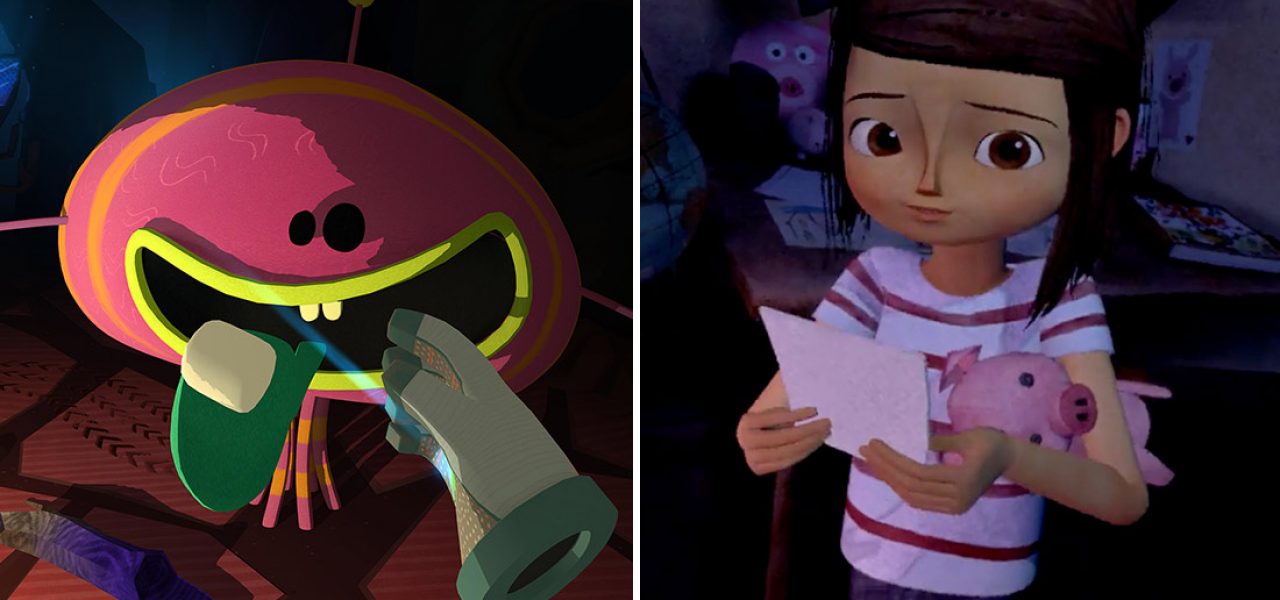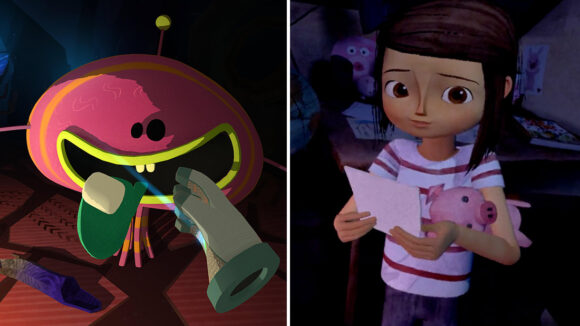

Review: VR Projects At Tribeca Film Festival Offer New Levels Of Immersion And Empathy
While vr has had a continually growing and evolving presence at the Tribeca Film Festival since 2012, this year felt like a leap towards solidifying its place in visual storytelling. With 22 vr film experiences curated for Tribeca’s Virtual Arcade, attendees had a massive range of styles, linear and non-linear narratives, gameplay, and immersion.
That being said, the best advice is to attend multiple showings and to get there early. If you’ve only got time for one of the ticketed 3-hour blocks, then doing your homework was essential – you had to come in knowing the top projects you wanted to check out. Compared to last year, the scheduling system was vastly improved, with audiences being able to select their own times rather than the first-come-first-served setup from last year.
At the start of each session, attendees were let in, and it was a mad dash to the kiosks of your must-see pieces. Attendees selected an available time, added their cell number, and moved on to the next one. If you factored in the run time of each piece (which ranged from 6 to 40 minutes), you could optimize your schedule. Of course, it got tougher as slots were claimed and the varying lengths of the shorts clashed, so it was also important to be open to the unexpected. With only minimal gaps in my schedule I was able to see six of the 22 films, so multiple sessions would be required to see everything on offer.
A Truly Immersive Experience
While immersion is of course a staple of vr, the level and interpretation of it often varies from project to project. This year, with two shorts in particular, those levels deepened in new ways. Saying game-changing may seem hyperbolic, but with the character interaction, production quality, and storytelling, Baobab’s Bonfire and Fable Studio’s Wolves in the Walls set a new bar to strive for.
From Baobab Studios and directed by Eric Darnell (who is also the studio’s chief creative officer), Bonfire sets up a fun world and simple premise — you’re a pilot crash-landed on a new planet with your robot assistant (voiced by Ali Wong), and you’re not quite sure if the locals are friendly.
The main character you meet, Pork Bun, responds to the various actions you take, which means the story can play out differently for each person. Although stationary throughout the piece, you never feel confined. It never feels stop-and-go like some vr experiences. The seamlessness, both between the animated cycles and response triggers, was so smooth that I was fully committed to the story as it played out.
I think with vr, people are hesitant to allow themselves to truly dive in — they’re afraid of looking silly, or are too aware that it isn’t real, but the fun in this one is to let go. It wants you to try things, laugh with the characters, believe them. The amount of agency you feel you have as the main character certainly helps.
As director Darnell told Cartoon Brew, “When you have this character that you really feel like you have a relationship with…you can take empathy to the next level. You start with the stages of engagement — pity, sympathy, empathy, and then if you can actually take that empathy and turn it into action, then you have that passion. And so we’re trying to drive the audience to take passionate action based upon this relationship they develop with the character, so they feel like they can suspend their disbelief enough to feel like the choices that they’re making have real stakes and that they really matter.”
Similarly, with Wolves in the Walls: It’s All Over, a short created by Pete Billington and Jessica Yaffa Shamash via Fable, I found myself moving, unprompted, to sit on the ground next to the main character, a young girl named Lucy. It felt rude not to sit down with her as she drew and chatted excitedly about the alleged wolves that lived within the walls of her family house. Having her eyeline move lower as I sat was one of those subtle things that simultaneously sold the technology to me while humanizing Lucy.
As we explored, meeting and interacting with her parents and brother in various rooms, I was completely drawn in to her feelings and her reactions to me. While the narrative and interactions were more guided and linear, the ability to move about the world, and the way the world was shifted and expanded through Lucy’s imagination, made for a whimsical story that leaves one thinking about it long after the experience ends. Wolves in the Walls: It’s All Over is the first and second chapters of a planned three-chapter story. I look forward to the conclusion of Lucy’s story.
Actors Up the Ante
With headsets becoming more affordable and mobile, the question I initially had was what the appeal of a festival was when many of these projects are or will become available online. Humans have always loved a shared experience, and while many pieces allow you to experience a piece passively with a couple other attendees, this was the first time I experienced pieces with a real actor present. This added yet another layer of interaction and immersion at Tribeca, and offered a unique experience for ticket-holders.
At the start of Wolves in the Walls, an actress was there mostly to help set up the vr headset, but there was a performative element to it. The closed-in room, intended for one viewer at a time, was set-dressed to look like Lucy’s attic. The actress shuffled through boxes, pulling one out and digging through it until she pulled out the headset. At the end, she returns, bearing a strawberry jam cookie, a callback to a scene with Lucy’s mother. These were small touches for those at Tribeca, but lovely ones nonetheless.
The film that garnered the biggest reaction out of me was The Key, created by Celine Tricart. In it, we’re taken through a character’s memories as they are forced to leave their home in the clouds and travel to different worlds, all the while wondering what the cause of their displacement was.
The film culminates into the sobering reveal that this character and story are stand-ins for the refugee experience, particularly in Serbia. Before we even put the headset on, we enter a foggy room (courtesy of a fog machine), and meet an actress adorned in all-white. She watched us, almost ethereal, as speakers around your neck speak on her behalf. She sets up the story by swiping across monitors positioned around the room, assists you with the headset, and you’re on your way.
When the reveal happens — when you’re transported from this fantasy world to a real 360-degree photo of the remains of a Serbian home that was bombed, you then remove the headset and the actress takes over again, guiding you through the final part of the experience. She has you swipe the monitors, which now reveal facts about the global refugee crisis and a call to action. One fact reveals the film’s namesake, in that most refugees continue to hold onto their old house key well after they’ve left their homes. When the actress went from a mysterious, almost godlike entity and is then revealed to be a refugee — but more importantly, a human just like me – I saw once again the remarkable value in vr as a tool to empathetically inhabit and interact with characters.
Social Causes and Empathy
The running theme through all of these pieces is empathy. It’s effective in all types of storytelling, but especially so via interactions. The refugee story was effectively conveyed as a metaphor throughout The Key. As you travel, you lose things, friends, even the color of the world, and you are frustrated because you don’t understand why. In this situation, the limited options of the vr served to reinforce the helplessness of the narrative. Two other shorts I experienced were more direct in the social causes they were bringing to life, bringing audiences along more as an omniscient observer than anything else.
Another Dream, created by Tamara Shogaolu, is the true story of a lesbian couple from Egypt. Post-revolution backlash against the LGBT community causes them to flee their home for the Netherlands, leaving behind everything they know in order to be together. While at times the pacing was a bit slow, it didn’t stop the story from being a gripping and stressful one to witness, as they dealt with family pressure, crossing various borders, and never knowing when they’d feel safe in their identities.
Drop in the Ocean, created by Adam May, Chris Campkin, and Chris Parks, had the most elaborate set at Tribeca, with an LED-clad space evoking a giant jellyfish. Once inside, attendees geared up and moved around a small area, looking around them as a narrator spoke. First, we started off microscopic, floating in the ocean among tiny organisms, only to have microplastics in the water pointed out to us.
We scale up and watch as jellyfish eat them, then as a larger turtle eats a plastic bag mistaken for a jellyfish. The message was loud and clear as we looked up and the surface of the water was nothing but trash. The contrast of the beauty of the marine life swimming around us and the dire reality of the situation was unpleasant, but necessary. As audiences left the space, infographics lined the wall with information from one of the project’s collaborators Conservation International on how to help clean the oceans.
